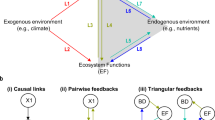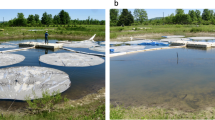Abstract
Producers, such as plants and algae, acquire nutrients from inorganic sources that are supplied primarily by decomposers whereas decomposers, mostly fungi and bacteria, acquire carbon from organic sources that are supplied primarily by producers. This producer–decomposer co-dependency is important in governing ecosystem processes1,2,3,4, which implies that the impacts of declining biodiversity on ecosystem functioning5,6,7 should be strongly infuenced by this process. Here we show, by simultaneously manipulating producer (green algal) and decomposer (heterotrophic bacterial) diversity in freshwater microcosms, that algal biomass production varies considerably among microcosms (0.0–0.67 mg ml-1), but that neither algal nor bacterial diversity by itself can explain this variation. Instead, production is a joint function of both algal and bacterial diversity. Furthermore, the range in algal production in microscosms in which bacterial diversity was manipulated was nearly double (1.82 times) that of microcosms in which bacterial diversity was not manipulated. Measures of organic carbon use by bacteria in these microcosms indicate that carbon usage is the mechanism responsible for these results. Because both producer8 and microbial diversity9 respond to disturbance and habitat modification, the main causes of biodiversity loss8, these results suggest that ecosystem response to changing biodiversity is likely to be more complex than other studies5,6,7 have shown.
This is a preview of subscription content, access via your institution
Access options
Subscribe to this journal
Receive 51 print issues and online access
$199.00 per year
only $3.90 per issue
Buy this article
- Purchase on Springer Link
- Instant access to full article PDF
Prices may be subject to local taxes which are calculated during checkout


Similar content being viewed by others
References
Harte, J. & Kinzig, A. P. Mutualism and competition between plants and decomposers: implications for nutrient allocation in ecosystems. Am. Nat. 141, 839–846 (1993).
Kaye, J. P. & Hart, S. C. Competition for nitrogen between plants and soil microorganisms. Trends Ecol. Evol. 12, 139–143 (1997).
Berman-Frank, I. & Dubinsky, Z. Balanced growth in aquatic plants: myth or reality? BioScience 49, 29–37 (1999).
Wall, D. H. & Moore, J. C. Interactions underground. BioScience 49, 109–117 ( 1999).
Tilman, D. et al. The influence of functional diversity and composition on ecosystem processes. Science 277, 1300– 1302 (1997).
Naeem, S. & Li, S. Consumer species richness and autotrophic biomass. Ecology 79, 2603– 2615 (1998).
Hooper, D. U. & Vitousek, P. M. The effects of plant composition and diversity on ecosystem processes. Science 277, 1302–1305 (1997).
Wilcove, D. S., Rothstein, D., Dubow, J., Philips, A. & Losos, E. Quantifying threats to imperiled species in the United States. BioScience 48, 607– 615 (1998).
Borneman, J. & Triplet, E. W. Molecular microbial diversity in soils from Eastern Amazonia: Evidence for unusual microorganisms and microbial population shifts associated with deforestation. Applied Environ. Microbiol. 63, 2647–2653 (1998).
Griffiths, B. S., Ritz, K. & Wheatley, R. E. in Microbial Communities (eds Insam, H. & Rangger, A.) 1–9 (Springer, Berlin, 1997).
Wood, A. M. & Van Valen, L. M. Paradox lost? On the release of energy-rich compounds by phytoplankton. Marine Microbial Food Webs 4, 103–116 ( 1990).
Jones, A. K. The interaction of algae and bacteria. in Microbial interactions and communities (eds Bull, A. T. & Slater, J. H.) 189– 247 (Academic, London, 1982).
Berman, T. & Holm-Hanse, O. Release of photoassimilated carbon as dissovled organic matter by marine phytoplankton. Mar. biol. 28, 305–310 ( 1974).
Zak, D. R. & Grigal, D. F. Nitrogen mineralization, nitrification and denitrification in upland and wetland ecosystems. Oecologia 88, 189–196 ( 1991).
del Giorgio, P. A. & Cole, J. J. Bacterial growth efficiency in natural aquatic systems. Annu. Rev. Ecol. System. 29, 503–541 ( 1998).
Zak, D. R., Grigal, D. F., Gleeson, S. & Tilman, D. Carbon and nitrogen cycling during old-field succession: constraints on plant and microbial biomass. Biogeochemistry 11, 111– 129 (1990).
Hobbie, S. E. Effects of plant species on nutrient cycling. Trends Ecol. Evol. 7, 336–339 ( 1992).
Naeem, S., Haakenson, K., Thompson, L. J., Lawton, J. H. & Crawley, M. J. Biodiversity and plant productivity in a model assemblage of plant species. Oikos 76, 259–264 (1996).
Allsopp, D., Colwell, R. R. & Hawksworth, D. L. (eds) Microbial Diversity and Ecosystem Function (CAB International, Oxon, 1995).
Bochner, B. R. Sleuthing out bacterial identities. Nature 339, 157–158 (1989).
Schlesinger, W. H. Biogeochemistry 3nd edn (Academic, San Diego, 1997).
Pritchard, P. H., Mueller, J. G., Lantz, S. E. & Santavay, D. L. in Microbial Diversity and Ecosystem Function (eds Allsopp, D., Colwell, R. R. & Hawksworth, D. L.) 161–182 (CAB International, Oxon, 1995).
Elser, J. J., Dobberfuhl, D. R., MacKay, N. A. & Schampel, J. H. Organism size, life history and N:P stoichiometry. BioSciecne 46, 674–684 (1996).
Lawton, J. H. et al. Biodiversity inventories, indicator taxa and effects of habitat modification in tropical forest. Nature 391, 72–79 (1998).
Mulder, C. P. H., Koricheva, J., Huss-Danell, K., Högberg, P. & Joshi, J. Insects affect relationships between plant species richness and ecosystem processes. Ecol. Lett. 2, 237–246 (1999).
Van der Heijden, M. G. A. et al. Mycorrhizal fungal diversity determines plant biodiversity, ecosystem variability and productivity. Nature 396, 69–72 (1998).
Wetzel, R. G. & Likens, G. E. Limnological Analyses (Springer, Berlin, Germany, 1991).
Porter, K. G. & Feig, Y. S. The use of DAPI for identifying and counting aquatic microflora. Limnol. Oceanogr. 25, 943–948 (1980).
Naeem, S. & Li, S. Biodiversity enhances ecosystem reliability. Nature 390, 507–509 (1997).
Smalla, K., Wachtendorf, U., Heuer, H., Liu, W.-T. & Forney, L. Analysis of BIOLOG GN substrate utilization patterns by microbial communities. Applied Environ. Microbiol. 64, 1220–1225 (1998).
Acknowledgements
We thank B. Bohanan, M. Brett, J. Cotner, A. Grack, S. Lawler, J. Lawton, P. Morin, D. Schindler and S. Tjossem for help, comments and discussion. This work was supported by the NSF.
Author information
Authors and Affiliations
Corresponding author
Rights and permissions
About this article
Cite this article
Naeem, S., Hahn, D. & Schuurman, G. Producer–decomposer co-dependency influences biodiversity effects . Nature 403, 762–764 (2000). https://doi.org/10.1038/35001568
Received:
Accepted:
Issue Date:
DOI: https://doi.org/10.1038/35001568
This article is cited by
-
Above- and belowground composition and diversity of subtropical plantations and their relationships with soil nutrient stocks
Plant and Soil (2024)
-
Pros and cons of Ulva lactuca and Cladophora glomerata grown in freshwater as feed
Environmental Science and Pollution Research (2022)
-
Species identity drives ecosystem function in a subsidy-dependent coastal ecosystem
Oecologia (2021)
-
Aridity-driven shift in biodiversity–soil multifunctionality relationships
Nature Communications (2021)
-
Meta-analysis shows positive effects of plant diversity on microbial biomass and respiration
Nature Communications (2019)
Comments
By submitting a comment you agree to abide by our Terms and Community Guidelines. If you find something abusive or that does not comply with our terms or guidelines please flag it as inappropriate.



